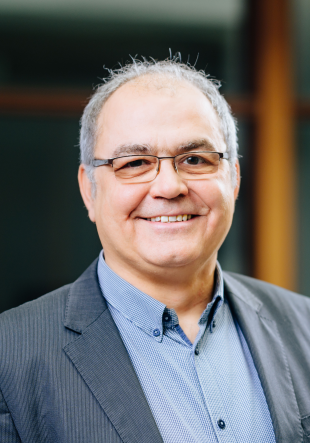NyPhE - Nyquist Silicon Photonics Engine
Overview
Exponentially growing data traffic around the world leads to increasing demand for high speed server communication in data centers. Future communication systems have to reach data rates well beyond 100 Gbits/s and low power dissipation is becoming an increasingly important characteristic. Therefore, novel transceiver concepts are required to enable efficient high speed communication between servers. Silicon photonics enable high cost- and power-efficiency through integration of optical and electrical devices on a single chip, but data rates are limited by the small bandwidth of optical modulators in silicon technology. In the NyPhE project we investigate a new modulation concept to overcome the bandwidth limitations of silicon photonics transmitters. By means of sophisticated signal processing a bandwidth which is at least 3x the bandwidth of the silicon photonics optical modulators shall be achieved.

Figure 1: Application of Nyquist transceivers in data centers
The main goal of the NyPhE project is the development of high speed electro-optical transceivers for data rates up to 400 Gbit/s. The basic approach to reach these data rates, is to make use of sequentially modulated and added Nyquist pulses [1]. Due to their rectangular frequency spectrum, sequentially added Nyquist pulses do not influence each other and intersymbol interference is avoided.

Figure 2: Transceiver structure and operating principle, CW: continuous wave, MZM: Mach-Zehnder modulator, BR: balanced receiver, TIA: transimpedance amplifier
The rectangular spectrum is approximated by a frequency comb (see fig. 2a) which is generated by a MZM with a RF signal and a CW laser input. The optical signal is split into several channels, delayed and modulated by MZMs separately (see fig. 2b). Afterwards the modulated signals are combined and send to the receiver (see figure 2c). Thus, only a fraction of bandwidth is needed in each modulator. In the receiver, the signal is split up into channels again. Each channel signal is multiplied with a Nyquist pulse and demodulated in a BR. Afterwards the channel signals are amplified and converted into a serial signal.
The NyPhE project is funded by the Bundesministerium für Bildung und Forschung (BMBF). Our project partners are the Institut für Hochfrequenztechnik TU Braunschweig under the direction of Prof. Dr. Thomas Schneider, the Institut für Hochfrequenztechnik TU Dresden under the direction of Prof. Dr.-Ing. Kambiz Jamshidi, Sicoya GmbH and Leoni AG.
References
[1] Soto, M.A.et al., “Optical sinc-shaped Nyquist pulses of exceptional quality,” Nat.Commun. (2013).
Key Facts
- Grant Number:
- 13N14882
- Project duration:
- 04/2019 - 03/2022
- Funded by:
- BMBF
More Information
Contact
If you have any questions about this project, contact us!
Christian Kress, M.Sc.
Transregional Collaborative Research Centre 142
Wissenschaftlicher Mitarbeiter

Tobias Schwabe, M.Sc.
System and Circuit Technology / Heinz Nixdorf Institut
Wissenschaftlicher Mitarbeiter























